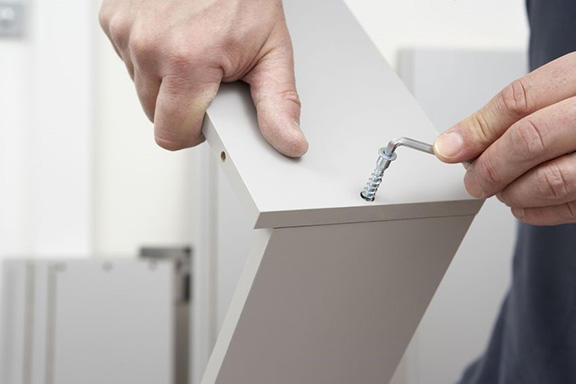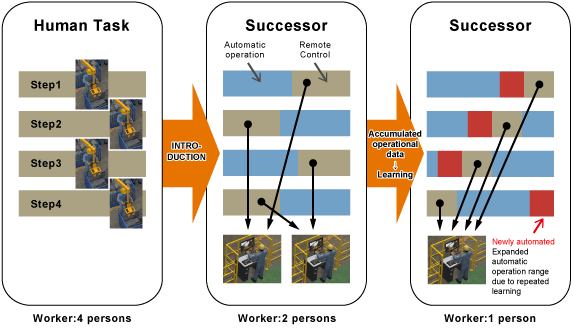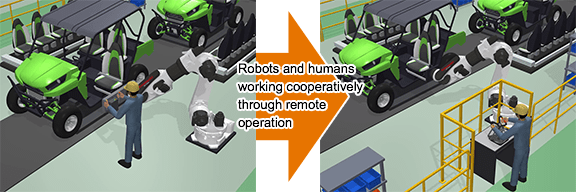The obstacles in robot automation
Recently, industrial robots have been working for various tasks previously performed by humans. An example is the spot-welding robots found in automobile factories that melt and attach separate steel plate parts together with heat. Yet, obstacles still exist to achieve automation by robots; did you know that in the manufacturing industry, most of the work is still accomplished by humans and only about 3% (※1) is conducted by robots?
In order to deploy robots in manufacturing processes, it is necessary to instruct them beforehand through the process of programming. An engineer with expertise in robot programming specifies each movement, and only then can it be possible for the robot to be in a task-ready mode. This programming process has been impractical for scenarios such as when the work requires human intuition or when the production scale is small. Specifically, it is a tedious, time-consuming process for robot engineers to analyze and program the robots to replicate the movement of skilled technicians which is produced from their many years of experience, intuition, and ability to respond accordingly to occasional changes in the work environment. Moreover, in situations when different products have to be produced each time, such as with custom orders, manufacturing by humans is far cheaper and faster rather than having a robot handle it. It is for this reason, from an economic perspective, that robots have been considered unsuitable for automation in many fields.
(※1)According to the report “World Robotics 2017”, announced by the International Federation of Robotics (IFR), as of 2016, 303 robots were used for every 10,000 employees in the Japanese manufacturing industry. This is the fourth highest figure following after Korea, Singapore, and Germany.
The problem of jobs requiring human “senses”

When the shape and position of the work piece is kept consistent, and all that is required are simple, linear movements, then an automated process using robots is comparably easier and has been traditionally done. However, procedures are not always like this in actual work sites. The shape and position of work can subtly change, and there are times that a decision is required depending on the situations for tasks where human senses distinguish differences in things like vibrations, shock and sounds. Because of this, tasks that depend on a worker’s sense of touch and hearing, for example, telling the difference between varying levels of clatter, are done by humans.
However, with the declining birth rate and increasing population of the elder, the labor force is steadily decreasing. Many industries, especially manufacturing, are facing these issues and struggling to figure out how to retain the work force and how to go about transferring the skills of expert workers.
A new solution to the difficulties of robotics automation
Announced by Kawasaki in November 2017, the “Successor” is a new robot system which allows humans to operate robots remotely while reproducing the same environment of the work. The system makes it possible for robots and humans to work together harmoniously and proposes new possibilities for robots, such as the transfer of skills from expert workers. It is expected that this robot system will bring big advancement in introducing robots into fields traditionally deemed difficult to robotize.
Making robots work as humans do
Remote operation of a robot becomes possible with the use of the “Communicator”, a special apparatus which functions to transmit information on the human movement to the robot. The Communicator makes intuitive tasks possible by being set up in a way suited to the work and outfitted with the ability to provide sensory feedback to the operator through the device. This gives the operator the feeling of actually being in the workspace and makes performing operations become almost intuitive, so on-site technicians most familiar with the task can personally control the robot and simultaneously give hands-on instructions on how to perform the task. This process of handing down skills—exactly like how a master does work while the disciple watches and learns—is being made possible for robots.

Traditionally, automation using robots progressed with a focus on mass production where the shape and position of work pieces were kept constant during processes. With the Successor, robots will be installed to the manufacturing processes of products with frequent model changes, those with customized parts, or even those with a small production volume.
The Successor does not automate all steps in the manufacturing processes; it allows partial automation through autonomous operation of the robot once it learns the movements of a human through the Communicator. By freely switching between remote operation using the Communicator and automatic operation by robots, strengths of both humans and robots are utilized in good coordination, and the best of both worlds can be achieved.
Accelerated automation through AI learning
Furthermore, with Artificial Intelligence (AI), it becomes possible for the Successor to learn by itself. As the more human-initiated operational data accumulates, the more the learning advances. Therefore, even if there are data variations, the robot can examine it using its AI, determine the best course of action, and switch over to automatic operation. This feature will significantly widen the scope of the tasks for automation as a result.
As an example, imagine that there are 4 steps in a manufacturing line (below, left figure). To start, one robot is brought in for each step, and one person is assigned to operate one robot. The robot learns from operational data accumulated through each repetition of the task and then becomes capable of doing the task by itself, thus making the task automated. The remaining steps are done by remote operation by humans, but since a part of the process has become automatic, one person can now control two robots (below, middle figure). Then, if the automation advances through the robot’s AI capabilities, then all four steps of the process need only be handled by a single person operating four robots (below, right figure).

Collaboration of humans and robots through remote operation
Within the realm of robots that work together with humans, robots can coexist in the same space, but in the case of larger robots that handle loads of several hundred kilograms, they either have to be isolated within safety fences, or for those that work near humans, their movements have to be slowed down to ensure the safety of the human. Despite these measures, it may still be difficult for humans to psychologically feel safe in actual situations where robots work in a close distance. With the use of the Successor, tasks can be done collaboratively wherein the worker feels like he is working on-site with the robot even while separated from it, making it possible to maximize the robot’s potential while securing personal safety.

Establishing the next generation with a new style of collaboration
As previously stated, in the recent years, the use of industrial robots has been widespread, mainly centered on large-scale production factories such as those in the automobiles industry. However, the technologies of the Successor are not limited to large robots; they can be applied to small ones or essentially any type of robot as well. Its key advantages include allowing anyone to program work processes to a robot without special knowledge and being capable of learning and mastering tasks by itself. These features greatly lower the bar for automation. It can be expected that the usage of robots will expand, even in manufacturing lines and factories that have either given up on or did not previously consider implementing robots.
Labor shortage is not only a problem in the manufacturing industry; it is also forecasted to affect many other fields, and attention is now being drawn to the utilization of robots. At present, robots are becoming more widespread, seeping from the inner bounds of factories into general society and there has been consideration about bringing them into many different places including construction sites, disaster recovery situations, and even offices and commercial facilities. And with the appearance of the Successor, even for industrial fields that once considered robots to be far-off entities, the reality of humans working in collaboration with robots has perhaps inched even closer.